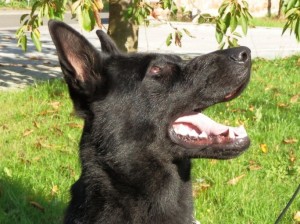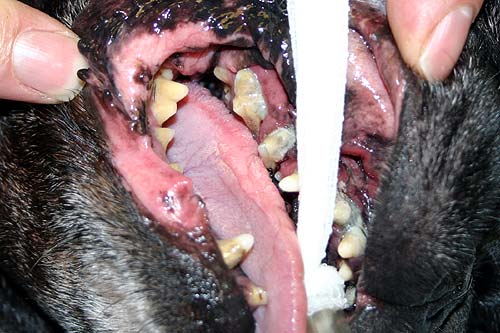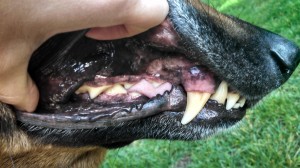Diet: Foundation for a Healthy Mouth
 There’s nothing quite like a gleaming row of pearly whites! Unfortunately, for many dogs the adult teeth do not stay that beautiful bright white for very long. Within a few short years after those adult teeth come in, those pearly whites are now stained and covered with brown plaque and tartar. In fact, by the age of 3, over 80% of dogs have some form of periodontal disease, which makes this a very serious issue. A variety of remedies are suggested, ranging from special teeth-cleaning commercial foods and treats to dental cleanings performed under anesthesia. As with just about every other aspect of the dog’s health, it really all starts with diet.
There’s nothing quite like a gleaming row of pearly whites! Unfortunately, for many dogs the adult teeth do not stay that beautiful bright white for very long. Within a few short years after those adult teeth come in, those pearly whites are now stained and covered with brown plaque and tartar. In fact, by the age of 3, over 80% of dogs have some form of periodontal disease, which makes this a very serious issue. A variety of remedies are suggested, ranging from special teeth-cleaning commercial foods and treats to dental cleanings performed under anesthesia. As with just about every other aspect of the dog’s health, it really all starts with diet.
The Role of Diet
The first step in keeping teeth clean is taking control over the food that goes into the dog’s mouth. Contrary to popular lore, a kibbled diet does not keep a dog’s teeth clean. If this were the case, then 80% of dogs over the age of three would not have periodontal disease! In fact, kibble does the exact opposite, no matter how crunchy or large the kibbles are. Very little scrubbing action occurs on a kibble diet, as many dogs scarf their food in typical carnivore fashion rather than chew thoroughly. The only portion of the tooth that receives any abrasive action is the tip, even with larger kibbles. For dogs that do chew their kibbles, the carbohydrate-rich food leaves a soft, gooey material that then sticks to the gum line and encourages the formation of plaque and tartar.  Additionally, the sugars and simple carbohydrates in the food create a plentiful food source for bacteria, allowing them to proliferate. This is what eventually leads to gingivitis and periodontal disease. This photo here on the right, for example, is of an 8-year-old pug who had been fed commercial food its entire life. This is a graphic example of the poor tooth-cleaning effects of a kibbled food.
Additionally, the sugars and simple carbohydrates in the food create a plentiful food source for bacteria, allowing them to proliferate. This is what eventually leads to gingivitis and periodontal disease. This photo here on the right, for example, is of an 8-year-old pug who had been fed commercial food its entire life. This is a graphic example of the poor tooth-cleaning effects of a kibbled food.
A diet that incorporates raw meaty bones, on the other hand, provides plenty of chewing action that naturally cleans, flosses, and polishes teeth. The dog must use his teeth as they were designed, to rip and tear meat and crush up edible bones.  These teeth pictured here at left, for example, are of a seven-year-old German Shepherd Dog who has been fed a raw diet since he first started eating solid food as a puppy. Despite some age-related staining (some staining is normal, but tartar buildup is not), and some wear and tear from Schutzhund training and trialing, these teeth are in excellent condition for a dog of his age. We have noticed that the teeth and gums of all our raw-fed dogs are in excellent condition well into old age, seeming to defy that 80% statistic.
These teeth pictured here at left, for example, are of a seven-year-old German Shepherd Dog who has been fed a raw diet since he first started eating solid food as a puppy. Despite some age-related staining (some staining is normal, but tartar buildup is not), and some wear and tear from Schutzhund training and trialing, these teeth are in excellent condition for a dog of his age. We have noticed that the teeth and gums of all our raw-fed dogs are in excellent condition well into old age, seeming to defy that 80% statistic.
Additional Ways to Keep Teeth Clean
There are additional ways to keep your dog’s teeth and gums healthy, although these are all secondary to a proper diet. If you feed commercial food or ground raw food, you will need to incorporate some of these secondary preventive measures in order to prevent tartar buildup, gingivitis, and periodontal disease. Additionally, if you own a brachycephalic or small breed dog prone to dental disease (as many toy breeds are), you will need to be very aggressive in keeping your dog’s teeth clean. They are already at a disadvantage due to missing or overcrowded teeth in a smaller mouth. Next blog, we will discuss some of the secondary options for keeping teeth and gums healthy.

